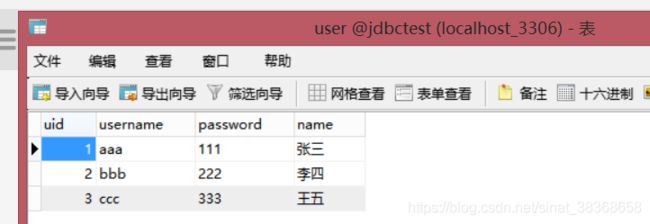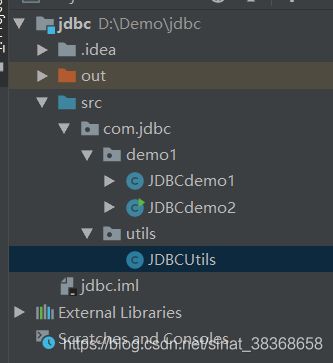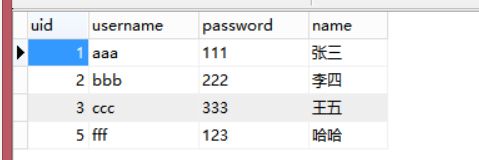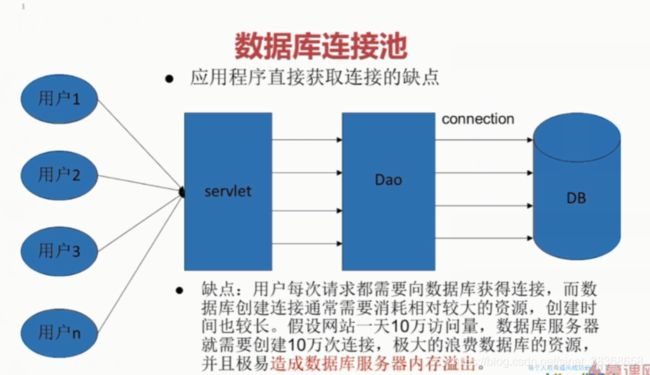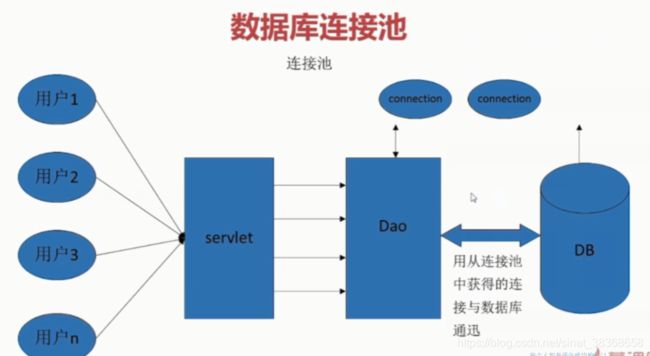JAVA数据库操作——JDBC入门教程
本文章主要内容:
- JDBC概述
- JDBC入门
- JDBC的API详解
- JDBC的资源释放
- JDBC的CURD操作
- JDBC工具类的抽取
- JDBC的PreparedStatement
正式进入正文
一、JDBC概述
JDBC:java database Connectcivity(java数据库连接)

二、JDBC入门
使用java操作数据库的步骤:
- 搭建开发环境
- 编写程序,在程序中加载数据库驱动
- 建立连接
- 创建用于向数据库发送SQL的statement对象
- 从代表结果集的ResultSet中取出数据
- 断开与数据库的连接,并释放相关资源
create database jdbctest;
use jdbctest;
create table user(
uid int primary key auto_increment,
username varchar(20),
password varchar(20),
name varchar(20)
);
insert into user values(null,'aaa','111','张三');
insert into user values(null,'bbb','222','李四');
insert into user values(null,'ccc','333','王五');
然后使用idea连接数据库:
IDEA使用JDBC连接MySQL数据库详细教程
https://blog.csdn.net/qq_36172505/article/details/84102468
编写代码
package com.jdbc.demo1;
import java.sql.*;
public class JDBCdemo1 {
//JDBC的入门程序
public void demo1(){
try{
//1.加载驱动
//DriverManager.registerDriver(new Driver());//会导致驱动注册两次
Class.forName("com.mysql.cj.jdbc.Driver");
//2.获得连接
Connection con = DriverManager.getConnection("jdbc:mysql://localhost:3306/jdbctest?serverTimezone=GMT","root","123456");
//3.创建sql语句,并且执行sql
//3.1创建执行sql的对象
String sql = "select * from user";
Statement stmt = con.createStatement();
//3.2执行sql
ResultSet resultSet = stmt.executeQuery(sql);
while(resultSet.next()){
int uid = resultSet.getInt("uid");
String username = resultSet.getString("username");
String password = resultSet.getString("password");
String name = resultSet.getString("name");
System.out.println(uid+" "+username+" "+password+" "+name);
}
//4.释放资源
resultSet.close();
stmt.close();
con.close();
}catch (Exception e){
e.printStackTrace();
}
}
public static void main(String[] args) {
JDBCdemo1 demo1 = new JDBCdemo1();
demo1.demo1();
}
}
三、JDBC的API详解
DriverManager:驱动管理类
- 主要作用:
- 一、注册驱动
- 实际开发中注册驱动使用如下的方式
Class.forName(“Com.mysql.cj.jdbc.Driver”); - 因为之前的方式会导致驱动注册两次
- 实际开发中注册驱动使用如下的方式
- 二、获得连接
- connection getConnnection(String url,String username,String passsword);
- url写法:jdbc:mysql://localhost:3306/jdbc
- jdbc:协议
- mysql:子协议
- localhost:主机号
- 3306:端口号
- url简写:jdbc:mysql:///jdbc
- url写法:jdbc:mysql://localhost:3306/jdbc
- connection getConnnection(String url,String username,String passsword);
- 一、注册驱动
Connetcion:连接驱动
- 主要作用
- 一、创建执行sql语句的对象
Statement createStatement():执行sql语句,有sql注入的漏洞存在
PreparedStatment prepareStatement(String sql): 预编译sql语句,解决sql注入的漏洞
CallableStatement prepareCall(String sql): 执行sql中存储过程 - 二、进行事务的管理
setAutoCommit(boolean autoCommit) : 设置是否是否自动提交
commit(): 事务提交
rollback(): 事务回滚
- 一、创建执行sql语句的对象
Statement:执行sql语句
- 主要作用
- 一、执行sql语句
boolean execute(String sql): 执行sql,执行select语句返回true,否则返回false
ResultSet executeQuery(String sql): 执行sql中的select语句
int executeUpdate(String sql): 执行sql中的insert/update/delete语句 - 二、执行批处理操作
addBatch(String sql): 添加到批处理
executeBatch(): 执行批处理
clearBatch():清空批处理
- 一、执行sql语句
ResultSet:结果集
- 结果集:其实就是查询(Select)语句查询的结果的封装
- 主要作用:
结果集获取查询到的结果
next():针对不同的类型的数据可以使用getxxx()获取数据,通用的获取数据的方法:getObject();
四、JDBC的资源释放
- jdbc程序运行完后,要释放程序在运行过程中,创建的那些与数据库进行交互的对象,这些对象通常是ResultSet,Statement和Connection对象
- 特别是Connection对象,是非常稀有的资源,用完后必须马上释放,如果Connection不能及时正确的关闭,极易导致系统宕机,Connection的使用原则是尽量晚创建,尽量早释放
根据这样的原则我们重写连接数据库的代码:
package com.jdbc.demo1;
import java.sql.*;
public class JDBCdemo2 {
//JDBC的入门程序
public void demo1(){
Connection con = null;
Statement stmt = null;
ResultSet resultSet = null;
try{
Class.forName("com.mysql.cj.jdbc.Driver");
con = DriverManager.getConnection("jdbc:mysql://localhost:3306/jdbctest?serverTimezone=GMT","root","123456");
String sql = "select * from user";
stmt = con.createStatement();
resultSet = stmt.executeQuery(sql);
while(resultSet.next()){
int uid = resultSet.getInt("uid");
String username = resultSet.getString("username");
String password = resultSet.getString("password");
String name = resultSet.getString("name");
System.out.println(uid+" "+username+" "+password+" "+name);
}
}catch (Exception e){
e.printStackTrace();
}finally {
if (resultSet!=null) {
try {
resultSet.close();
} catch (SQLException e) {
resultSet = null;
}
resultSet = null;
}
if (stmt!=null){
try {
stmt.close();
} catch (SQLException e) {
e.printStackTrace();
}
stmt = null;
}
if (con!=null)
{
try {
con.close();
} catch (SQLException e) {
e.printStackTrace();
}
con = null;
}
}
}
}
五、JDBC的CURD操作
- 插入数据库中的记录
- 修改
- 删除
- 查询
package com.jdbc.demo1;
import java.sql.*;
public class JDBCdemo2 {
//查询方法
//查询一条记录
public void demo5(){
Connection conn = null;
Statement stmt = null;
ResultSet rs =null;
try {
Class.forName("com.mysql.cj.jdbc.Driver");
conn = DriverManager.getConnection("jdbc:mysql:///jdbctest?serverTimezone=GMT","root","123456");
stmt = conn.createStatement();
String sql = "select * from user where uid = 2" ;
rs = stmt.executeQuery(sql);//返回的int值代表影响的行数
if (rs.next()){
System.out.println(rs.getInt("uid")+" "+rs.getString("username")+" "+rs.getString("password")+" "+rs.getString("name"));
}
}catch (Exception e){
e.printStackTrace();
}finally {
//释放资源
if (rs!=null) {
try {
rs.close();
} catch (SQLException e) {
e.printStackTrace();
}
rs = null;
}
if (stmt!=null){
try {
stmt.close();
} catch (SQLException e) {
e.printStackTrace();
}
stmt = null;
}
if (conn!=null){
try {
conn.close();
} catch (SQLException e) {
e.printStackTrace();
}
conn = null;
}
}
}
//查询方法
//查询所有记录
public void demo4(){
Connection conn = null;
Statement stmt = null;
ResultSet rs =null;
try {
Class.forName("com.mysql.cj.jdbc.Driver");
conn = DriverManager.getConnection("jdbc:mysql:///jdbctest?serverTimezone=GMT","root","123456");
stmt = conn.createStatement();
String sql = "select * from user" ;
rs = stmt.executeQuery(sql);//返回的int值代表影响的行数
//遍历结果集
while (rs.next()){
System.out.println(rs.getInt("uid")+" "+rs.getString("username")+" "+rs.getString("password")+" "+rs.getString("name"));
}
}catch (Exception e){
e.printStackTrace();
}finally {
//释放资源
if (rs!=null) {
try {
rs.close();
} catch (SQLException e) {
e.printStackTrace();
}
rs = null;
}
if (stmt!=null){
try {
stmt.close();
} catch (SQLException e) {
e.printStackTrace();
}
stmt = null;
}
if (conn!=null){
try {
conn.close();
} catch (SQLException e) {
e.printStackTrace();
}
conn = null;
}
}
}
//删除方法
public void demo3(){
Connection conn = null;
Statement stmt = null;
try {
Class.forName("com.mysql.cj.jdbc.Driver");
conn = DriverManager.getConnection("jdbc:mysql:///jdbctest?serverTimezone=GMT","root","123456");
stmt = conn.createStatement();
String sql = "delete from user where uid = 4" ;
int i = stmt.executeUpdate(sql);//返回的int值代表影响的行数
if (i>0) {
System.out.println("删除成功!");
}
}catch (Exception e){
e.printStackTrace();
}finally {
//释放资源
if (stmt!=null){
try {
stmt.close();
} catch (SQLException e) {
e.printStackTrace();
}
stmt = null;
}
if (conn!=null){
try {
conn.close();
} catch (SQLException e) {
e.printStackTrace();
}
conn = null;
}
}
}
//修改方法
public void demo2(){
Connection conn = null;
Statement stmt = null;
try {
//注册驱动
Class.forName("com.mysql.cj.jdbc.Driver");
//获得连接
conn = DriverManager.getConnection("jdbc:mysql:///jdbctest?serverTimezone=GMT","root","123456");
//获得执行sql语句的对象
stmt = conn.createStatement();
//编写sql
String sql = "update user set username = 'qqq',password='456',name = '赵六' where uid = 4" ;
//执行sql
int i = stmt.executeUpdate(sql);//返回的int值代表影响的行数
if (i>0) {
System.out.println("修改成功!");
}
}catch (Exception e){
e.printStackTrace();
}finally {
//释放资源
if (stmt!=null){
try {
stmt.close();
} catch (SQLException e) {
e.printStackTrace();
}
stmt = null;
}
if (conn!=null){
try {
conn.close();
} catch (SQLException e) {
e.printStackTrace();
}
conn = null;
}
}
}
//保存操作
public void demo1(){
Connection conn = null;
Statement stmt= null;
try{
//注册驱动
Class.forName("com.mysql.cj.jdbc.Driver");
//获得连接
conn = DriverManager.getConnection("jdbc:mysql:///jdbctest?serverTimezone=GMT","root","123456");
//获得执行sql语句的对象
stmt = conn.createStatement();
//编写sql
String sql = "insert into user values (null,'eee','123','刘大')";
//执行sql
int i = stmt.executeUpdate(sql);
if (i>0){
System.out.println("保存成功!");
}
}catch (Exception e){
e.printStackTrace();
}finally {
//释放资源
if (stmt!=null){
try {
stmt.close();
} catch (SQLException e) {
e.printStackTrace();
}
stmt = null;
}
if (conn!=null){
try {
conn.close();
} catch (SQLException e) {
e.printStackTrace();
}
conn = null;
}
}
}
public static void main(String[] args) {
JDBCdemo2 demo2 = new JDBCdemo2();
demo2.demo5();
}
}
六、JDBC工具类的抽取
上一节的不同方法中很多代码酒店重复的
package com.jdbc.utils;
import java.sql.*;
/*
JDBC的工具类
*/
public class JDBCUtils {
private static final String driverClass;
private static final String url;
private static final String username;
private static final String password;
static {
driverClass = "com.mysql.cj.jdbc.Driver";
url = "jdbc:mysql:///jdbctest?serverTimezone=GMT";
username = "root";
password = "123456";
}
/*
注册驱动的方法
*/
public static void loadDriver() throws ClassNotFoundException
{
Class.forName(driverClass);
}
/*
获得连接的方法
*/
public static Connection getConnection() throws Exception
{
loadDriver();
Connection conn = DriverManager.getConnection(url,username,password);
return conn;
}
/*
资源释放
*/
public static void release(Statement stmt,Connection conn)
{
if (stmt!=null){
try {
stmt.close();
} catch (SQLException e) {
e.printStackTrace();
}
stmt = null;
}
if (conn!=null){
try {
conn.close();
} catch (SQLException e) {
e.printStackTrace();
}
conn = null;
}
}
public static void release(ResultSet rs,Statement stmt,Connection conn)
{
if (rs!=null) {
try {
rs.close();
} catch (SQLException e) {
e.printStackTrace();
}
rs = null;
}
if (stmt!=null){
try {
stmt.close();
} catch (SQLException e) {
e.printStackTrace();
}
stmt = null;
}
if (conn!=null){
try {
conn.close();
} catch (SQLException e) {
e.printStackTrace();
}
conn = null;
}
}
}
现在我们写一个测试函数来测试我们的工具类
package com.jdbc.demo1;
import com.jdbc.utils.JDBCUtils;
import java.sql.Connection;
import java.sql.Statement;
public class JDBCdemo3 {
//保存记录
public void demo1(){
Connection conn = null;
Statement stmt = null;
try{
conn = JDBCUtils.getConnection();
stmt = conn.createStatement();
String sql = "insert into user values (null,'fff','123','哈哈')";
int num = stmt.executeUpdate(sql);
if (num>0){
System.out.println("保存成功!");
}
}catch (Exception e){
e.printStackTrace();
}finally {
JDBCUtils.release(stmt,conn);
}
}
public static void main(String[] args) {
JDBCdemo3 demo3 = new JDBCdemo3();
demo3.demo1();
}
}
七、JDBC的PreparedStatement
便于移植和编译,通常将数据库url,name,password等提取到一个配置文件里,需要的时候从配置文件里解析。一般使用属性文件表示。


package com.jdbc.utils;
import java.io.IOException;
import java.io.InputStream;
import java.sql.*;
import java.util.Properties;
/*
JDBC的工具类
*/
public class JDBCUtils {
private static final String driverClass;
private static final String url;
private static final String username;
private static final String password;
static {
//加载属性文件并解析:
Properties props = new Properties();
//如何获得属性文件的输入流
//通常使用类的加载器的方式进行获取:
InputStream is = JDBCUtils.class.getClassLoader().getResourceAsStream("jdbc.properties");
try {
props.load(is);
} catch (IOException e) {
e.printStackTrace();
}
driverClass = props.getProperty("driverClass");
url = props.getProperty("url");
username = props.getProperty("username");
password = props.getProperty("password");
}
//后面不变
}
JDBC的SQL注入漏洞
package com.jdbc.demo2;
import com.jdbc.utils.JDBCUtils;
import java.sql.Connection;
import java.sql.ResultSet;
import java.sql.Statement;
//演示JDBC的注入的漏洞
public class JDBCdemo4 {
//测试sql注入漏洞的方法
public void demo1(){
boolean flag = JDBCdemo4.login("aaa","111");
if (flag == true)
System.out.println("登录成功!");
else
System.out.println("登陆失败!");
}
public static boolean login(String username, String password) {
Connection conn = null;
Statement stmt = null;
ResultSet rs = null;
boolean flag = false;
try {
conn = JDBCUtils.getConnection();
stmt = conn.createStatement();
String sql = "select * from user where username = '" + username + " 'and password = '" + password + "'";
rs = stmt.executeQuery(sql);
if (rs.next()) {
flag = true;
} else {
flag = false;
}
} catch (Exception e) {
e.printStackTrace();
} finally {
JDBCUtils.release(stmt, conn);
}
return flag;
}
public static void main(String[] args) {
JDBCdemo4 demo4 = new JDBCdemo4();
demo4.demo1();
}
}

如果我们修改用户名,再瞎写一个密码,可以看到,都登录成功了。


为什么有这种情况?这就是sql注入的漏洞的产生,产生的原因就是我们在输入用户名的时候输入了sql的一个关键字
sql注入漏洞的解决

不使用statment。使用preparedStatment
package com.jdbc.demo2;
import com.jdbc.utils.JDBCUtils;
import java.sql.Connection;
import java.sql.PreparedStatement;
import java.sql.ResultSet;
import java.sql.Statement;
//演示JDBC的注入的漏洞
public class JDBCdemo4 {
//测试sql注入漏洞的方法
public void demo1(){
boolean flag = JDBCdemo4.login2("aaa","111");
if (flag == true)
System.out.println("登录成功!");
else
System.out.println("登陆失败!");
}
//避免sql注入漏洞的方法
public static boolean login2(String username, String password) {
Connection conn = null;
PreparedStatement pstmt = null;
ResultSet rs = null;
boolean flag = false;
try {
//获得连接
conn = JDBCUtils.getConnection();
//编写sql
String sql = "select * from user where username = ? and password = ?";
//预处理sql
pstmt = conn.prepareStatement(sql);
//设置参数
pstmt.setString(1,username);
pstmt.setString(2,password);
//执行sql语句
rs = pstmt.executeQuery();
if (rs.next()) {
flag = true;
} else {
flag = false;
}
} catch (Exception e) {
e.printStackTrace();
} finally {
JDBCUtils.release(pstmt, conn);
}
return flag;
}
public static void main(String[] args) {
JDBCdemo4 demo4 = new JDBCdemo4();
demo4.demo1();
}
}
使用PreparedStatement
PreparedStatement的使用
使用PreparedStatement完成的增删改查代码
package com.jdbc.demo2;
//preparedStatment的使用
import com.jdbc.demo1.JDBCdemo2;
import com.jdbc.utils.JDBCUtils;
import java.sql.*;
public class JDBCdemo5 {
//查询方法
//查询一条记录
public void demo5(){
Connection conn = null;
PreparedStatement pstmt = null;
ResultSet rs = null;
try{
conn = JDBCUtils.getConnection();
String sql = "select * from user where uid = ?";
pstmt = conn.prepareStatement(sql);
pstmt.setObject(1,2);
rs = pstmt.executeQuery();
while (rs.next()){
System.out.println(rs.getInt("uid")+" "+rs.getString("username")+" "+rs.getString("password")+" "+rs.getString("name"));
}
}catch (Exception e){
e.printStackTrace();
}finally {
JDBCUtils.release(rs,pstmt,conn);
}
}
//查询方法
//查询所有记录
public void demo4(){
Connection conn = null;
PreparedStatement pstmt = null;
ResultSet rs = null;
try{
conn = JDBCUtils.getConnection();
String sql = "select * from user";
pstmt = conn.prepareStatement(sql);
rs = pstmt.executeQuery();
while (rs.next()){
System.out.println(rs.getInt("uid")+" "+rs.getString("username")+" "+rs.getString("password")+" "+rs.getString("name"));
}
}catch (Exception e){
e.printStackTrace();
}finally {
JDBCUtils.release(rs,pstmt,conn);
}
}
//删除方法
public void demo3(){
Connection conn = null;
PreparedStatement pstmt = null;
try{
conn = JDBCUtils.getConnection();
String sql = "delete from user where uid = ?";
pstmt = conn.prepareStatement(sql);
pstmt.setInt(1,6);
int num = pstmt.executeUpdate();
if (num>0){
System.out.println("删除成功!");
}
}catch (Exception e){
e.printStackTrace();
}finally {
JDBCUtils.release(pstmt,conn);
}
}
//修改方法
public void demo2(){
Connection conn = null;
PreparedStatement pstmt = null;
try{
conn = JDBCUtils.getConnection();
String sql = "update user set username = ?,password = ? ,name = ? where uid = ?";
pstmt = conn.prepareStatement(sql);
pstmt.setString(1,"www");
pstmt.setString(2,"123456");
pstmt.setString(3,"张六");
pstmt.setInt(4,6);
int num = pstmt.executeUpdate();
if (num>0){
System.out.println("修改成功!");
}
}catch (Exception e){
e.printStackTrace();
}finally {
JDBCUtils.release(pstmt,conn);
}
}
//保存操作
public void demo1(){
Connection conn = null;
PreparedStatement pstmt = null;
try{
conn = JDBCUtils.getConnection();
String sql = "insert into user values (null,?,?,?)";
pstmt = conn.prepareStatement(sql);
pstmt.setString(1,"qqq");
pstmt.setString(2,"123");
pstmt.setString(3,"张五");
int num = pstmt.executeUpdate();
if (num>0){
System.out.println("保存成功!");
}
}catch (Exception e){
e.printStackTrace();
}finally {
JDBCUtils.release(pstmt,conn);
}
}
public static void main(String[] args) {
JDBCdemo5 demo5 = new JDBCdemo5();
demo5.demo5();
}
}


